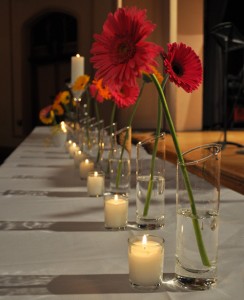
For students in U of G’s human anatomy program, words can’t express the gratitude they feel toward the donors whose last gift was the gift of a lifetime: their own bodies. Students say the knowledge they gain studying a human body is greater than any textbook could provide.
The human anatomy program held a Celebration of Life and Learning in War Memorial Hall on April 5 to honour those who donated their bodies. As students spoke in turn about the impact the program has had on their lives, another student lit a candle and placed a flower in a vase to commemorate each donor.
“Our main purpose this evening is to give thanks to the donors whose final gift of their bodies contributes to the advancement of our understanding of the human body,” said pastor Jon Fogleman, who presided over the service. He referred to the donors as heroes for their selfless act of generosity that gives students a new perspective on life and death.
The anatomy program touches students on a personal level, said Michael Emes, dean of the College of Biological Sciences. “I never cease to marvel as our students tell the story of what each donor has meant to them and how they have been personally transformed by that experience. Our donors leave an indelible mark on all who have benefitted from their generosity.”
Introduced in the 1960s by the late biomedical science professor William Boyd, the human anatomy program has expanded from one course to several courses at U of G and the University of Guelph-Humber, including a third-year course that involves full-body dissection and a fourth-year advanced anatomy course. Of the 300 students in the third-year course, only 25 are admitted into the fourth-year course. Guelph is one of the few universities in North America to offer a full-body human dissection program at the undergraduate level, an experience usually reserved for professional schools.
The anatomy program also offers workshops to high school and college students, including advanced-care paramedic students at Conestoga College in Kitchener and Fanshawe College in London.
The donors’ impact goes beyond the classroom, said Gary Sullivan, professor of anatomy and physiology at Fanshawe College. “It’s a gift to science; it’s a gift to education; it’s also a gift to the lives of our students. More importantly, it’s a gift to the lives of all the people that these students will eventually touch” as physicians, emergency-care workers, respiratory therapists and sports trainers.
Despite advances in computer simulations and robotic patients, the human body is still the best learning tool, said Sullivan, adding that his students are often so moved by the experience that they talk about it for weeks.
Emily Martin, a graduate of Everest College in Hamilton who now works as a registered massage therapist, said a field trip to U of G’s human anatomy lab gave her a better understanding of human physiology than a textbook ever could. Before the students were allowed to enter the lab, they were reminded that they were about to view “mothers, fathers, siblings and loved ones who were each special to someone and had made this unbelievably generous choice,” said Martin. “There was emphasis on the enormity of the gift and the respect due to the donors.”
When Martin’s grandmother passed away in February, her body was donated to the human anatomy program. “I was impressed by the sympathy, gratitude and professionalism of the staff, and that helped me know that our family was making the right decision at a difficult time,” said Martin.
For more information about the human body donation program, visit www.uoguelph.ca/humananatomy, email anatomy@uoguelph.ca or call the 24-hour human body donation line at 519-400-4630.